
The Armenian-Speaking Muslims of Hamshen: Who Are They? (Part 4)
By Vahan Ishkhanyan
Hamshesnak: The Hamshen Armenian Dialect
- How do you say ‘bat’ in Armenian? Harun asks in Turkish
- Chghtchik, Khachik answers, and you?
- We say mashkatev
- Interesting, mashk (skin) and tev (arm), I say.
Harun is surprised. The word mashk is no longer used in the Hamshen dialect, only appearing in the word for “bat”.
Due to Anahit’s condition of being yerkutak (Armenian for “two-folded”) we caught on that the Hamshen version of pregnant is ergutak. Cemil and Harun call their language Hamshesnak or Homshesnak. Homshetsma is the accepted form in most academic research.
As I listen to the Hamshen dialect, I can’t understand a thing. It’s a foreign language to me. I had the same experience in Abkhazia. There, however, the Hamshen Armenians also knew literary Armenian. When I went in 2004, there were 38 Armenian schools. You could converse with people without the need of a translator’ as if you were talking to someone from Armenia. The Hamshens of Krasnodar don’t know literary Armenian, but you can converse with them in Russian. In Hopa, you’ll need a translator. After my ten day visit I was sure I could grasp the basics of the dialect if I stayed for a full month and interacted with the Hopa-Hamshens.
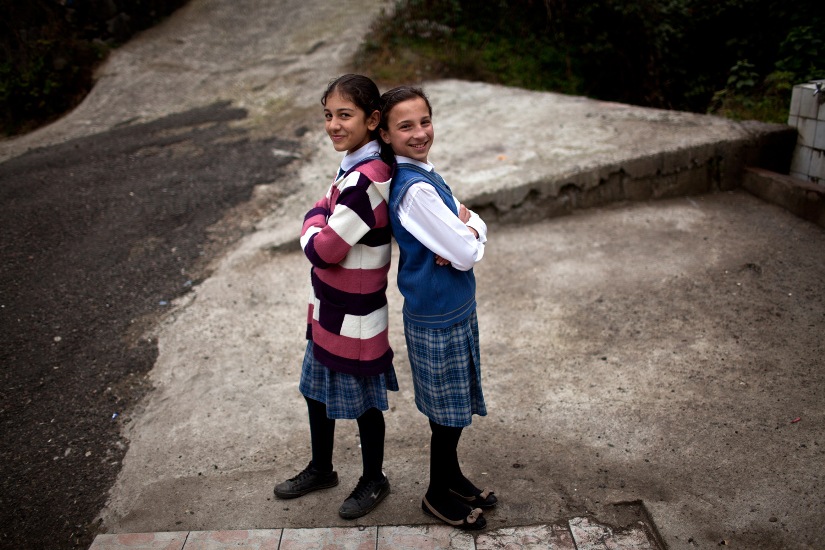 |
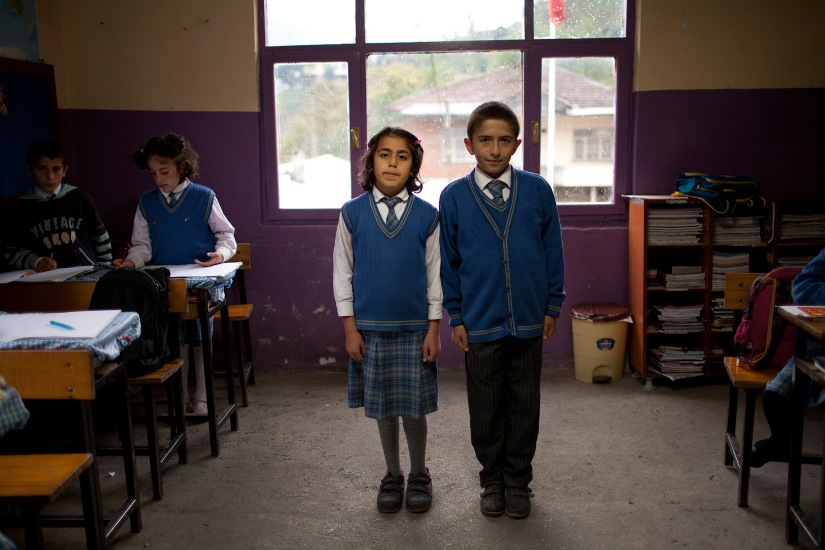 |
| The day when girls didn’t go to school is over. These Başoba 13 year-olds have already decided what they want to be. Betul Karagyoz wants to teach Englsih and Aybin Jaaogli wants to be a paediatrics doctor. | Başoba School: Children are not allowed to speak Hamshesnak |
When I really pay attention, I can make out Armenian words and gradually get a feel for the flow of the dialect. With some difficulty, I can even understand a sentence or two
For example: birthday - dzin or, moon - lousinka, stove - pechku, star - astakh, there is – go, it’s blowing – pcha gou, they took it – darin, in front of - arshin, tomorrow – kam or, village - kyagh, he’s not a man – mart cha, seashore - dziap, forest - tsakh, where are you coming from? – ousti goukas or ousten goukas? where are you going? – nor gertas?, center - ag, God gives us rain most of all – menashade asdvadz chakh gouda mez, I am looking – pout genim, good – soy, headscarf – yazma, how are you? – soyes ta?
In Yerevan, they also conversationally use the term outoush-khmoush for eating-drinking. I had heard the word outoush used in the Hamshen dialect once or twice and it turns out that the “el” suffix of a predicate is “oush” in the Hamshen dialect – porel/poroush (to dig), yergel/gonchoush or ganchoush (to sing), sovorel/gartoush (to learn) and the imperative form of to sing is gonchi.
Ajaryan in his “Study of the Hamshen Dialect” writes that before an “m” or “n”, the letter “a” becomes an “o”. “This is so widespread that it also impacts Turkish words. Tavan>tavo (scythe)[1]
As a child, my parents would often travel to the village of Loo near Sochi for the summers. The village was 80% Hamshen. I didn’t understand a thing. My father would tell me that if I listened hard I would learn. For example, I would ask him what does “eshtom Lo gom” mean? It means, “I’ll go to Lo and come back”. The “a” turns to “o” in both cases.
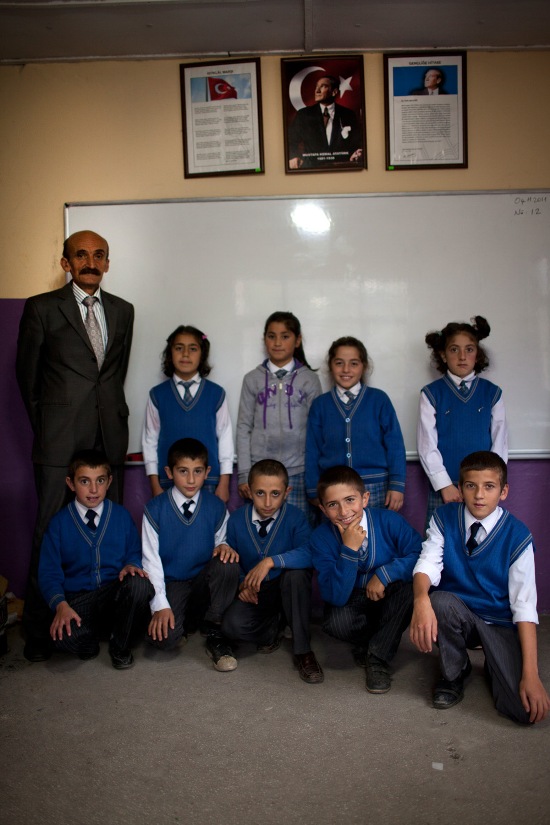 |
| Başoba School |
But the “a” doesn’t always become an “o”. They call a boy manch in Hopa villages but monch in Kemalpaşa.
Ajaryan’s research only dealt with the dialect of the Christian Hamshen. In the preface he writes that the first study was conducted in Trebizond in 1910 and in Gagra, during the Soviet period.
Sergey Vardanyan has complemented Ajaryan by studying the dialect of the Hopa-Hamshen. In his work Kronapokh hamshenahayeri barbaru, banahuysutyunu yev yergarvestu, (“The dialect, folklore and music culture of the Hamshen religious converts”), Vardanyan writes there are two branches of the Muslim Hamshen’s dialect based on the valley of residence: Hopa Valley residents or Ardeletsi, i.e. residents of villages around Ardala (Eşmekaya), and Kemalpaşa Valley residents or Turtsevantsi, i.e. ‘outsiders’ (probablyturs + avants‘i‘out-of-towner’).
Here are a few examples noted by Vardanyan in his research:
ankoghin/bargeldagh (bed) – Tatradz eni, medan bardeldaghe ou koun aghan (They were tired, went to bed and slept)
vorsord/avji (hunter); napastak/daoushon (rabbit) – Avjin daoushon tsvonets (The hunter killed the rabbit)
kourtzk/dzidz (breast) – Govoun dzidze gatov liktsadz er (The cow’s breast was full of milk)
voghnashar/bochkelokh (spine) – Bochkelokhe charevadz a (The spine was broken)K
koghm/semt (side) – Vor semtnious kenats? An semte (In what direction did he go? In that direction)
tzayr/dzay, jot (edge, end) – Chvonin dzaye (jote) dou indzi (Give me the end of the rope)
tcharp/yagh (fat, lard) – Adzoun yaghove gajerin mesadzin lerte (They rub the sick man’s back with fat)[2]:
Mothers Pass Down the Hamshesnak Language
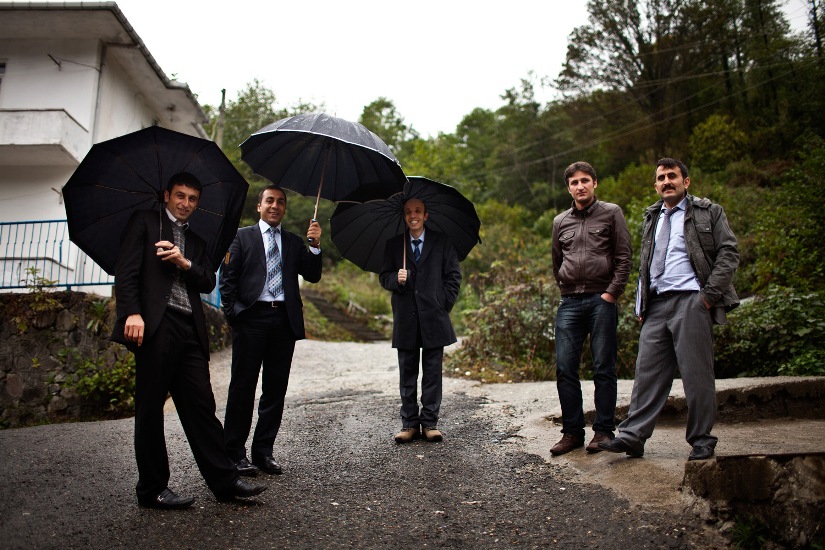 |
| Başoba School teachers |
At Cemal Vayiç’s home in Kayaköy, all present said that they didn’t know Turkish before entering school. In fact, no one over thirty understood Turkish before the age of seven; they only spoke Hamshesnak. They learnt it in school. There are women 70 years and older who still only speak Hamshesnak. They do not know Turkish and have no need of it. These seniors never went beyond the bounds of their village communities, never interacted with the world beyond. Men, on the other hand, had to learn Turkish for employment purposes.
Harun says that a policy to assimilate the Hopa-Hamshens started in the 1980s. School teachers are Turks, but there are always one or two locals as well. These Hamshen teachers are instructed to go out into the Hamshen villages and tell people that they must renounce “that language of theirs” in favor of Turkish. The argument used is that Hamshesnak holds the people back and prevents them from receiving an adequate education.
“I clearly remember one of the teachers kneeling down and explaining to me that I must learn Turkish because it’s the language used in school,” says Harun, “They also put pressure on the families, telling parents to teach Turkish to the children at home and not to speak Hamshesnak. My father was quite a severe guy and he would use scare tactics in order that I not speak Hamshesnak. Nevertheless, my dad continued to speak it at home because he knew it was the language I knew best. He still demanded that I only speak Turkish.”
“And your mother?” I ask.
“She never pressured me to speak Turkish.”
In Özcan Alper’s first film, Momi (Grandma), the old woman teaches her son to count in the Hamshen language. At the Golden Apricot film festival in Yerevan, Alper told me during an interview that he too didn’t know Turkish before entering school and learnt Hamshesnak mostly from his grandmother, who hardly knew Turkish. In his second film, Autumn, Yusuf, the main protagonist, speaks Hamshesnak with his mother.
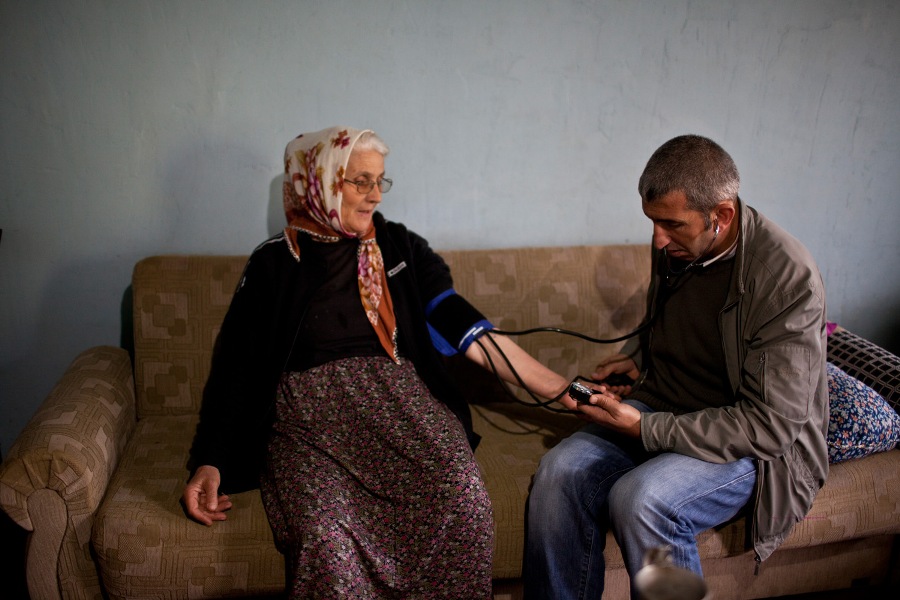 |
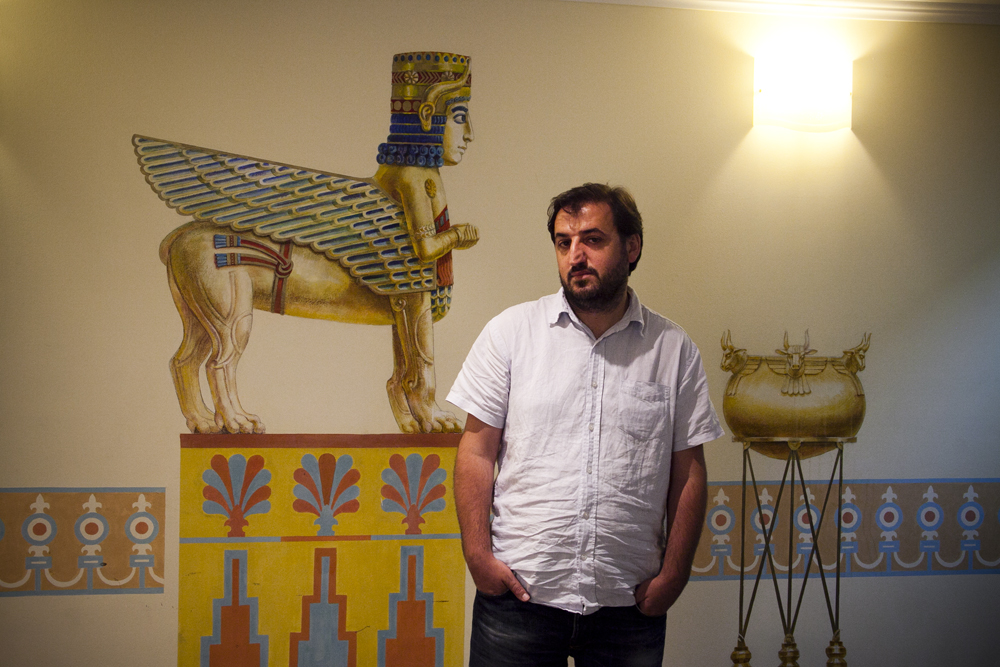 |
| Harun Aksu: “There was never any pressure from my mother | Director Özcan Alper at the 2011 Golden Apricot Film Festival in Yerevan (Photo: Inna Mkhitaryan) |
Hovann Simonian writes that the mothers are the ones who basically pass down the Hamshen language.[3]
Slowly, the use of Hamshesnak gave way to Turkish. Now, it’s rare to find preschoolers who don’t already know Turkish. They say there is one person left who still doesn’t know Turkish. A boy in Adapazarı went deaf at the age of ten and never learnt the language.
A young man working at Hotel Heyamo says he mostly speaks Hamshesnak with his mom and grandma; so as to appease their feelings.
“TV also played a play role in spreading Turkish,” says Harun, “In the 1980s everyone had a TV and the language entered our homes.”
In Turkey, it is forbidden to speak a language other than Turkish.
On the one hand, education and modernization is pulling the Hamshens down from the mountains onto the road of assimilation. On the flip side, a new world is opening up to them in the process and they are starting to search for their roots.
The school in Başoba opened in 1952 and education became mandatory. So what were people doing before that?
 |
| Kadir Aksu: “Let me make it short and simple. We aren’t people who would deny our roots” |
“They weren’t learning,” says 60 year-old Kadir Aksu who has served as the school’s principal for forty years. “There are still old folk who can’t read the modern Turkish alphabet and just know a smattering of Ottoman Turkish (Arabic script). When Ataturk changed the lettering, they started to build schools in the cities, but the villages remained without.”
Village children weren’t taken to the schools in the towns. Nobody had the financial means to give their kids an education. Everyone was poor.
When Kadir was a youngster, school was for five years. One had to go to the charshi (market/city) at a middle school. In Kadir’s case, he left in the middle of the five years and relocated to Arhavi where he completed high school.
Today, there’s a kindergarten and a nine grade school in the village of Başoba. The school has one hundred pupils and is famous for its academic achievements. To get a high school diploma, students have to go to Hopa.
“Are all the pupils Hamshentsi?” Even before my question could be translated, the female pupil waitress nodded her head in agreement. So she understood my Armenian. Only two of the twenty-six teachers are Hamshentsi.
It is forbidden to speak Hamshesnak in the school.
“We don’t let them speak it. Besides, the other teachers don’t understand the language,” says Kadir Aksu.
“And if you see anyone speaking it? Will you tell them to stop?
“That’s the law. But, hey, we aren’t dictators going around shutting people up.”
“In class, are the pupils told they are Hamshentsi?”
“We don’t teach them about such things. However, if a pupil asks ‘where do we come from?’ as an educator I am obliged to enlighten them.”
“So what do you tell them?”
“We tell them something in a convincing manner.”
“Who are the Hamshens in your opinion?”
“You sing the song of whoever’s horse you are riding. We are a people who have been subject to assimilation. We are here and our grandfathers were born and lived here. Talk to the villagers. We all know that we came here from somewhere else. My father used to tell me stories and later on I heard things from others. That’s how I formed an opinion.”
And what opinion have you reached?”
“Let me make a long story short. We aren’t the ones who would deny our roots.”
Hopa-Hamshens during the Soviet Era
Chagh goukar ou kenatser ander / It was raining and you left, ander
Tsoun gouka bor menatser ander / It was snowing, where were you, ander
Ersoun ochkharin ama ander / For thirty sheep, ander
Gurjistan menatser ander / You remained in Georgia, ander
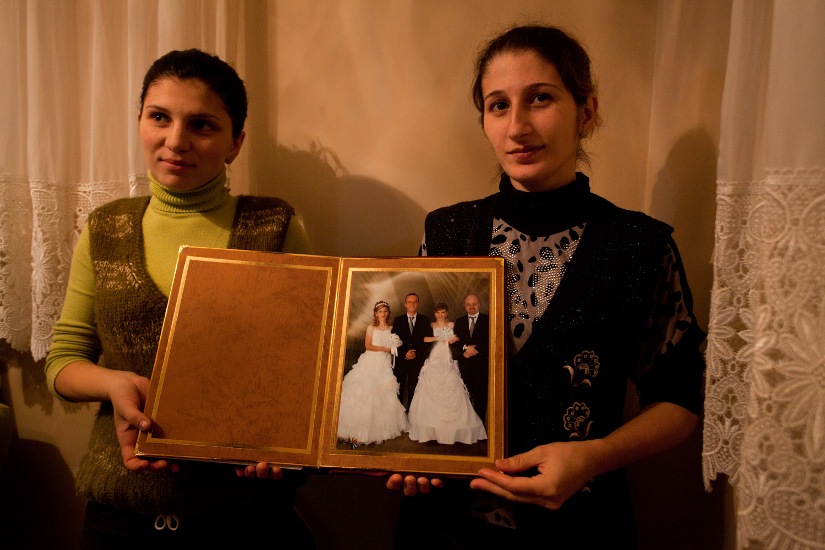 |
| Hava and Nargiza |
This song is about those married couples separated due to the closing of the Soviet-Turkish border. The woman is lamenting the loss of her shepherd husband, who took his flock into Georgia and now cannot come back home. The Soviet-Turkish border is closed, resulting in the separation of relatives from the same nationality living in different countries.
- The province of Artvin again reverted back to Turkey as a result of the 1921 Treaty of Batum. Most of the Hopa-Hamshen communities passed under Turkish dominion as well. Six villages remained on the Soviet side of the border. In the 1930s, when border crossing restrictions were tightened, sisters were separated from brothers and parents from their children.
- According to a 1944 decision by Stalin, 1,385 “Khemshin”, along with other Muslims (Turks and Kurds), were exiled to Kyrgyzstan and Kazakhstan as “unreliable population”. It was only after the death of Stalin that they were granted passports noting their nationality as “Khemsil” or sometimes Turk. [4]
- In the 1980s, Sergey Vardanyan met with Habib Koshanidze, a hemshil living in Kirgizia, who told him: “I am Armenian in origin and blood but Muslim in religion. My language is Armenian, the Hamshen dialect. Even though while at school I demanded that they register me as an Armenian, in my passport it reads khemshil. My first name is Arabic and my surname is Georgian. The authorities tricked us saying that if we change our last names we wouldn’t be deported. I was born in Kirgizia and went to a Russian school. I speak fluent Kazakh, Kirgiz, but do not know literary Armenian. What a world this is. What a people we are. What a fate. [5]
- According to Vardanyan’s research, in 1987 there were about 3,000 Muslim Hamshentsi in the Soviet Union. Starting in the 1970s, they began to move to the Belorechensky and Apsheronsky districts of Krasnodar in Russia. Due to the clashes with nationalists in 1989 in Central Asia, the exodus of Muslim Hamshentsi to Krasnodar became widespread. [6]
In the late 1980s, with the weakening of the Soviet border, the two segments of the once divided Hamshen people once again found each other. The passage of seventy years wasn’t enough to break all the ties. They once again exchanged brides. But it was enough for the two segments to have adopted new traditions that appeared foreign to one another.
Nargiza Mamoushevan only knew her future husband, Mumi Yılmaz, from a photo. Later she asked if he was a Turk. “If he’s a Turk, I don’t want to marry him.” They assured her he wasn’t a Turk but a Hamshentsi and that his people were just like them. “I asked her what was she, a Russian? She answered, ‘No, I too am not Russian but a Hamshentsi.’”Mumi relates.
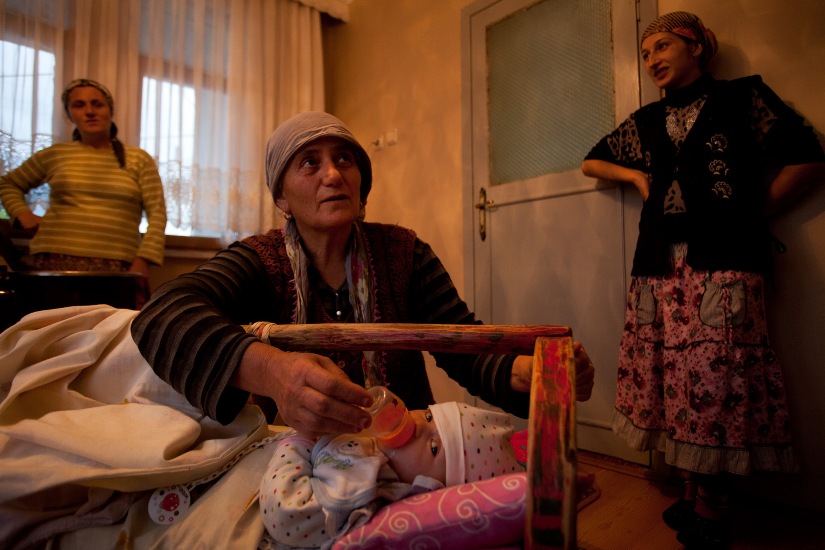 |
| Mumi’s mother Gyonul sings a lullaby for Elisultan |
In a way, Nargiza was lucky to have been born at a time when a bride at least was expected to find favor with her prospective husband, even if through the means of a photograph. It wasn’t that long ago when engagements were arranged sight unseen, and the girl only saw the man she was destined to marry on the wedding day.
Rather than send a photo, Mumi would go the region of Apsheronsk in Krasnodar to see Nargiza. The only thing preventing him wasn’t any custom but Turkish law, Mumi had spent several years in a Turkish prison and now he couldn’t leave Turkey for the next four years. Today his brother is in prison as well for hitting a policeman.
The two brothers wouldn’t have met their wives if Cihan hadn’t gotten into an accident in Krasnodar.
The Yılmaz family is from the village of Eşmekaya (former Ardala). Mumi proudly refers to himself as “Ardalatsi Mumi”; they are drivers. Two years ago, while driving near Sochi, Cihan lost control of his car and crashed. Some Homshetsma speaking people, whom he did not know, came to his assistance. They turned out to be from the same clan. “He’s the grandson of my grandma’s sister,” Mumi relates.
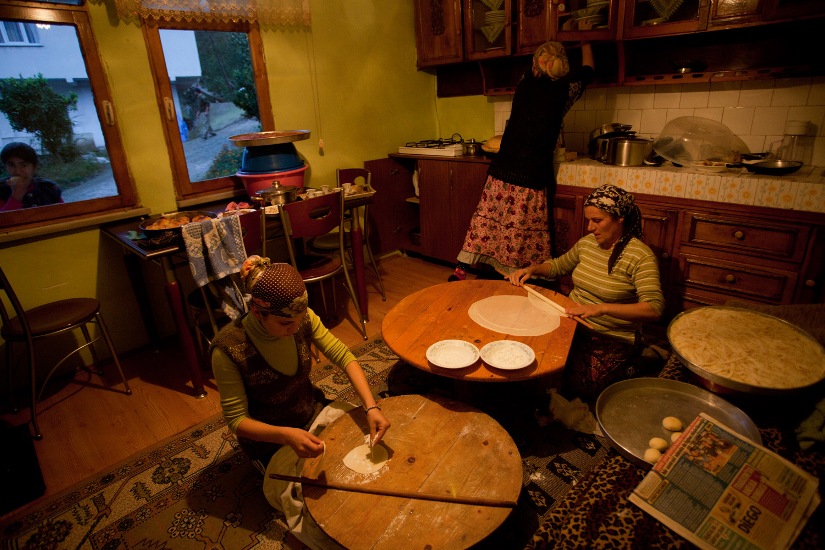 |
| The house of Mumi Yılmaz |
During the two weeks he stays in Apsheronsk, they introduce Cihan to his future wife, Hava Karacogli. “We met and liked what we saw,” Hava says.
Cihan returned and requested permission from his brother to marry. The Hamshen have a tradition whereby if the eldest brother hasn’t yet married, a younger brother wishing to marry must ask for his consent.
In 2010, the wedding of the two couples, the brothers from Hopa and the girls from Apsheronsk, takes place. 40 year-old Mumi Yılmaz is to marry 20 year-old Nargiza Mamoushevan, and Cihan Yılmaz is to wed 16 year-old Hava Karacogli. There are two wedding celebration, one in Apsheronsk without Mumi and according to the traditions of the Soviet Hamshens, and the other in Hopa.
| “No, we aren’t Armenian. It’s just that our language is similar, like Kazakh and Uzbek, or Kurdish and Persian. The same with Hamshen and Armenian is from the same group,” says 53 year-old Fayk Karaibrahimov. He relocated from Krghizia to Rostov, and then moved the family to Kemalpaşa, Turkey, in 1995. | 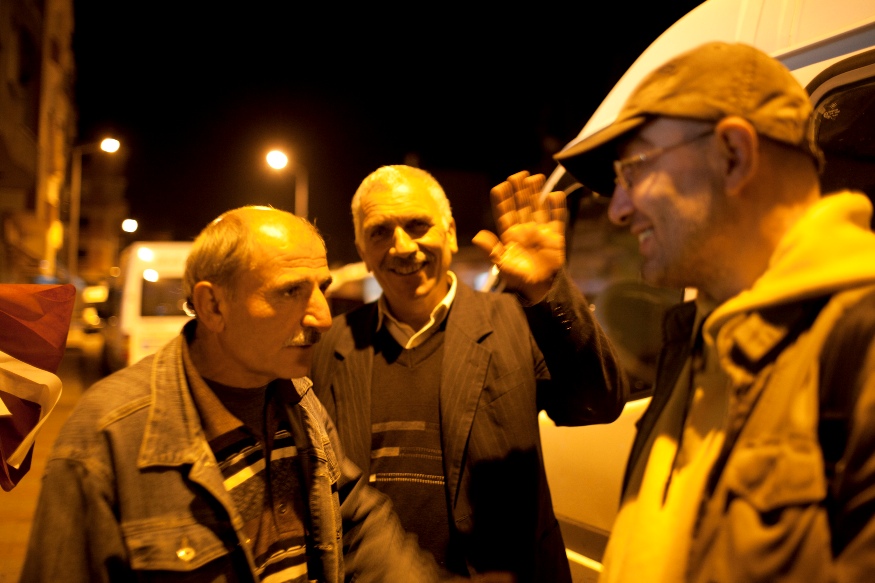 |
Hava already has a child and Nargiza is an expectant mother.
“I told them that I was still young, that I wanted to finish school and go on to college. They said ‘get married’, so I had no choice. You have to follow the words of the elders,” says Hava, who has just turned 17. We are in the Yılmaz family home in Eşmekaya. “Even if girls continue their education, after getting married, husbands don’t allow you to learn. That’s the custom with us,” Hava adds.
She tells us that in Krasnodar you won’t find women who have gone to school and who work. Hamshen women in Hopa have enjoyed much more freedom when it comes to education.
Başoba School Principal Kadir Aksu says that back in his time, girls didn’t even receive a high school education and would marry quite young. Today, girls are now being accepted into colleges in the big cities.
Hava was born in Apsheronsk and knows that her parents are from Central Asia. Nargiza was born in Kyrgyzstan and was six months old when the family relocated to Krasnodar. It was only when they came to Hopa that the two women found out that their grandfathers had been exiled from Batumi. At, home, no one talked about these things. “My parents only told me that a war broke out in Kirgizia and that we fled to Krasnodar,” says Nargiza.
Hava’s family in Apsheronsk has an Armenian neighbor and when they converse in their native tongue they understand much. “It’s my belief that Armenians and the Hamshen are the same people,” Hava says. Nargiza has a different opinion. “No, we are different. Armenians are Christian and we are Muslim.”
In Hopa, they only speak Homshetsma. No one understands their Russian. Their dialect and the one spoken in Hopa have remained basically the same, just some vocabulary is different. “Just a few words here and there are completely different. For example, they say mashina for a car and we say tilezhka. We say makina for a sewing machine but here it’s used to describe a laundry machine,” Nargiza explains.
But the customs are different. Nargiza continues: “Here, the women are all covered up and always with a head scarf. Unmarried girls must always cover their head. It’s not so rigid with us. If husbands allow it, wives can walk around without covering their heads. It’s only the older women that must cover up.”
In turn, the Hamshen from Turkey view their Soviet cousins as conservative. As Cemal Vayiç would point out, the Soviet Hamshen custom is for men and women to eat separately, unlike in Hopa. It’s true, walk into any Hamshen home in Hopa and the women will come up and shake the hand of a male stranger. Some women will even embrace close male friends and sit together at the table with them.
Nargiza says that they are much more conservative when it comes to family relationships. “The daughter-in-law doesn’t speak to the grandfather. If he wants her to talk, the grandfather will buy the girl a present. There’s no such custom in Hopa. I get the impression that people here go to the mosque more often. The Hamshentsi here are similar to the Russians when it comes to religious faith.”
The two young women brides are lucky to have wound up in the same house as brides. One consoles the other when they get homesick. They also visit other brides who have come from Krasnodar. Nargiza tells me that there are 43 women from Apsheronsk who have married into Hopa families.
“I told my husband that I’m getting bored sitting around the house. There’s nowhere to go and I have no relatives here. I dropped a hint about finding some work,” Nargiza says. “But he forbade me to work and says he can provide everything. Back home, my mother doesn’t work either. My father won’t allow it for the same reason.”
From the Hopa Black Sea coast, these women long for the Russian shores where life was more active and free. The towns there have many cafes and parks and women, just like men, can freely stroll around.
The way weddings are celebrated is the most striking difference between the two Hamshen communities. For those who were raised under Soviet rule, the passion for drinking and having fun at a wedding far surpassed any religious convictions. Feasting to the accompaniment of hard liquor was a mainstay at any wedding. As for the Hamshens of Turkey, despite the fact that they live in a nominally secular country, they remain more faithful to religious tenets. While they prepare a wedding table, hard alcohol is absent. It’s only after the wedding, when friends and family retire to the house of the groom, that the drinks are poured.
“We’d party all night at our weddings. The food and drink flowed freely. Not here. All they do is dance. There’s no outoush-khmoush (eating-drinking). Only after the wedding do they drink at home,” says Nargiza. “Our wedding was celebrated both ways. There, we partied with food and drink, here, there was no banquet table.”
(to be continued)
Khachatur Terteryan assisted in the research work.
Photos by Anahit Hayrapetyan Translated by Hrant Gadarigian
[1] Hrachya Ajaryan, Knnutyun hamsheni barbari (ASSR Academy of Sciences, 1947)
[2] Sergey Vardanyan, Kronapokh hamshenahayeri barbaru, banahuysutyunu yev yergarvestu (YSU, 2009)
[3] Ibid
[4] All information regarding the Soviet Hamshen is taken from: Sergey Vardanyan, Kronapokh hamshenahayeri barbaru, banahuysutyunu yev yergarvestu (YSU, 2009)
[5] Ibid
[6] Ibid
 Videos
Videos Photos
Photos
Comments (19)
Write a comment